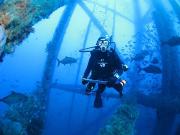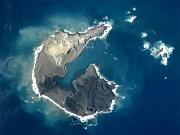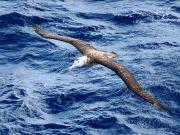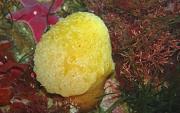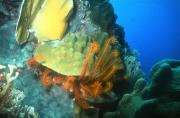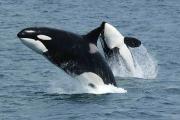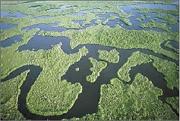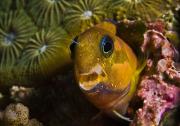Radio Program
Our regular Science and the SeaTM radio program presents marine science topics in an engaging two-minute story format. Our script writers gather ideas for the radio program from the University of Texas Marine Science Institute's researchers and from our very popular college class, Introduction to Oceanography, which we teach to hundreds of non-science majors at The University of Texas at Austin every year. Our radio programs are distributed at to commercial and public radio stations across the country.
In the darkness of the deep ocean, the faintest glimmer of light can mean the difference between life and death. It can scare away prey or draw in predators. So remaining completely dark can help a deep-sea fish catch a meal -- or avoid getting caught.
A recent study found some fish that have a big advantage in that area. Their skin is almost completely black -- it reflects no more than one-half of one percent of the light that strikes it. That makes the fish much darker than charcoal, and among the darkest living organisms on the planet.
Setting up an offshore oil rig takes a lot of time and money, and a lot of thought about the environment. And so does taking one down. California, for example, is pondering what to do with a couple of dozen platforms that have shut down or that are about to. And researchers have looked at what might happen to fish around those rigs.
Offshore platforms make good reefs. Mussels, oysters, and other shellfish latch on to the structure. Dead shells fall around the rig, providing good hiding places for small fish and other critters. That attracts larger fish.
A volcanic island in the western Pacific Ocean just can’t settle down. After not changing much for thousands of years, it’s undergone a series of eruptions in recent decades. That’s made it much bigger. And the eruptions may not be done.
Nishino-shima is about 600 miles south-southeast of Tokyo. It’s the tip of a volcano that rises two miles from the ocean floor.
The Tristan albatross is one of the largest sea birds on the planet. It has a 10-foot wingspan, which it uses to soar across millions of square miles of the Atlantic and Indian Oceans. But the albatross nests mainly on one small island in the South Atlantic -- and that’s been a big problem. House mice introduced to the island a century and a half ago are eating the eggs and chicks, and even attacking adults. That’s made the Tristan albatross a critically endangered species.
The striated frogfish has quite a resumé. It walks on the ocean floor, camouflages itself to avoid predators, carries its own fishing lure, and can gobble another fish faster than the blink of an eye. And it has a shaggy appearance that’s earned it a nickname: the hairy frogfish.
The fish is short and round -- only about eight or nine inches long. It lives in fairly warm, shallow waters around the world. In the United States, it’s found along the Atlantic coast from New Jersey southward, in the Gulf of Mexico, and in Hawaii.
Melanoma kills thousands of Americans every year, and attacks tens of thousands. So far, there’s no cure. But a potato-shaped organism in the waters around Antarctica may offer a solution. The organism produces a compound that’s shown some promise in treating this nasty form of skin cancer.
Sea lilies and feather stars are some of the most beautiful and delicate creatures in the oceans. Many of these animals resemble feather dusters, with the “feathers” colored orange, yellow, green, or other hues.
They’re also among the oldest sea creatures. Their ancestors date back hundreds of millions of years. Because of that, they’re sometimes called “living fossils.”
Sea lilies and feather stars are crinoids. They’re related to sea stars, urchins, and cucumbers. There are about 600 species in all.
Killer whales are a bit provincial. They’re split into small regional populations that stay on their own -- they almost never interact with others. The smallest of these groups is the Southern Resident population. It’s found in the Pacific Northwest. There are so few of the whales that they’re listed as an endangered species.
The population is split into three smaller groups, known as pods. Each pod consists of several families, which are headed by older females. Each pod has its own range, and even its own dialect.
Even if you live a thousand miles from the ocean, it still has an impact on your life. It provides food, fuel, and other resources. It’s a “superhighway” for transporting goods between countries. It provides jobs and attracts tourists. And it offers some of the most beautiful views on the planet. In short, it’s a critical resource -- and a common heritage -- for everyone on Earth.
A United Nations program is designed to preserve some of that heritage. It’s designated 50 World Heritage marine sites in 37 countries. They’re scattered across the whole planet.
The smallest fish on coral reefs appear to have two main jobs. One is to make more fish. And the other is to get eaten.
These little guys are known as cryptobenthic reef fishes. “Crypto” indicates that they’re mostly hidden, and “benthic” means they stay close to the ocean floor. Most are no more than half an inch long. They include thousands of species across many families. And because they’re so tiny and colorful, they’re sometimes called the Skittles or jellybeans of the reef.


